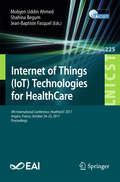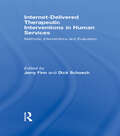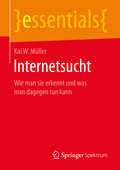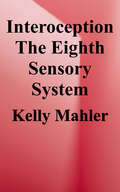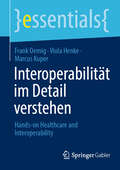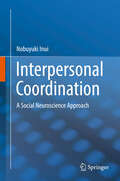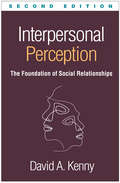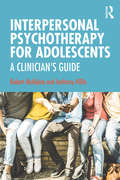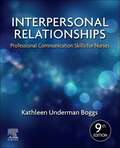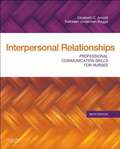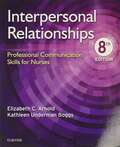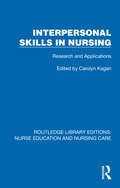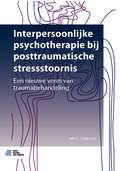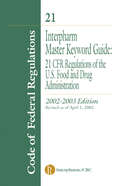- Table View
- List View
Internet of Things: 4thd International Conference, Healthyiot 2017, Angers, France, October 24-25, 2017, Proceedings (Lecture Notes of the Institute for Computer Sciences, Social Informatics and Telecommunications Engineering #225)
by Mobyen Uddin Ahmed Shahina Begum Jean-Baptiste BastelThis book constitutes the proceedings of the Fourth International Conference on Internet of Things (IoT) Technologies for HealthCare, HealthyIoT 2017, held in Angers, France, in October 2017. The IoT as a set of existing and emerging technologies, notions and services can provide many solutions to delivery of electronic healthcare, patient care, and medical data management. The 17 revised full papers presented were carefully reviewed and selected from 23 submissions. The papers cover topics such as healthcare support for the elderly, real-time monitoring systems, security, safety and communication, smart homes and smart caring environments, intelligent data processing and predictive algorithms in e-Health, emerging e-Health IoT applications, signal processing and analysis , the smartphones as a healthy thing, machine learning and deep learning, and cloud computing.
Internet-Delivered Therapeutic Interventions in Human Services: Methods, Interventions and Evaluation
by Jerry Finn Dick SchoechThere has been exponential growth in use of the Internet to deliver therapeutic and supportive human services. Online interventions are known by a variety of names, including online practice, e-therapy and others. All refer to the delivery of services over the Internet through a variety of delivery systems including asynchronous email, video and chat communication, and closed-circuit video conferencing. They include services delivered by professionals such as psychiatrists, social workers, psychologists, counsellors and nurses as well as self-help groups with a therapeutic purpose and supportive services provided by trained volunteers.This book presents the most current research on online practice. Topics include: descriptions of innovative online practice, evaluation studies of online practice with specific disorders, meta-analysis of the effectiveness of online practice, education and training of online practitioners, methods for the delivery of online practice, organizational policy and ethical issues related to online practice, online crisis intervention and hotline services, and considerations for meeting legal and ethical requirements of online practice. This book was originally published as a special issue of the Journal of Technology in Human Services.
Internetsucht: Wie man sie erkennt und was man dagegen tun kann (essentials)
by Kai W. MüllerKai W. Müller erläutert in diesem essential Hintergründe rund um das Phänomen der Internetsucht. Auf übersichtliche Art und Weise wird erklärt, was man unter Internetsucht versteht, welche Erkennungsmerkmale herangezogen werden, wie verbreitet dieses noch junge psychische Krankheitsbild ist und welche Hilfsangebote zur Verfügung stehen. Der Leser erhält zudem einen umfassenden Einblick in mögliche Ursachen für die Entstehung dieser Suchtproblematik.
Internistische Intensivmedizin für Einsteiger
by Johann Auer Dietmar ReitgruberDas vorliegende Werk liefert das Basiswissen für die Versorgung des internistischen Intensivpatienten – systematisch dargestellt, verständlich erklärt und mit vielen konkreten Tipps. Es wendet sich an Assistenzärzte in der Inneren Medizin, die im Rahmen ihrer Facharztweiterbildung auf die Intensivstation rotieren müssen und eine erste Anleitung für die Arbeit auf der Intensivstation benötigen. Dargestellt werden allgemeinen Prinzipien, wie apparative Diagnostik, Ernährung und Gerinnungsmanagement über spezielle Interventionen, wie Gefäßpunktionen, Schrittmacheranlage und Analgosedierung bis hin zum konkreten Vorgehen bei häufigen intensivpflichtigen Krankheitsbildern und Akutsituationen, wie akutes Koronarsyndrom, Herzrhythmusstörungen, ARDS und Intoxikationen. Ein praxisnahes Werk, mit dem der Einstieg in die internistische Intensivmedizin gelingt.
Internship Survival Guide (The\washington Manual Ser.)
by Thomas M. De FerPublisher's Note: Products purchased from 3rd Party sellers are not guaranteed by the Publisher for quality, authenticity, or access to any online entitlements included with the product. Substantially revised since the previous edition, this Internship Survival Guide offers first-year residents practical, real-world medical and professional guidance from senior residents and faculty advisors at the Washington University School of Medicine. Advice is presented in a concise, bulleted format, lending itself to quick comprehension of the material. You’ll learn the nuts and bolts of logistical issues and patient and colleague communication, as well as the basics of navigating your clinical rotations.
Interoception: The Eighth Sensory System
by Kelly MahlerInteroception, a newly identified eighth sense, allows us to "feel our internal organs and skin and gives information regarding the internal state or condition of our body." As such it is also a key component of our emotional experience. This is an area of difficulty for many, including those with autism spectrum disorders. <p><p>The book reviews the research underlying the effects of poor interoception and outlines strategies for how to ameliorate these effects.--Publisher
Interoperabilität im Detail verstehen: Hands-on Healthcare & Interoperability (essentials)
by Frank Oemig Viola Henke Marcus KuperDieses essential bietet einen Einstieg in die Fragestellung, was mit dem Begriff „Interoperabilität“ gemeint ist, der nicht nur den Datenaustausch zwischen IT-Systemen im Gesundheitswesen beschreibt. Dazu werden die in diesem Kontext häufig gebrauchten Begriffe wie Kompatibilität oder Konformität erläutert und in einen Zusammenhang gebracht. Weiterhin wird aufgezeigt, dass Interoperabilität das Ergebnis eines längeren Arbeits- und Austauschprozesses ist und wie „Interoperabilität“ für den erfolgreichen und reibungslosen Einsatz im Gesundheitssystem gemeinsam mit allen Stakeholdern weiterentwickelt werden kann.
Interpenetrating Polymer Network: Biomedical Applications
by Sougata Jana Subrata JanaThe book focuses on novel interpenetrating polymer network (IPN)/semi-IPN technologies for drug delivery and biomedical applications. The dynamism of the design and development of interpenetrating network polymers is based on their ability to provide free volume for the easy encapsulation of drugs in the three-dimensional network structure obtained by cross-linking two or more polymer networks. Natural polymer-based IPNs can deliver drugs at a controlled rate over an extended period of time, while novel IPNs ensure better mechanical strength and sustained/ controlled drug-delivery properties. This book presents an overview of the use of this technology to fabricate nanomedicine, hydrogels, nanoparticles, and microparticles, thereby unlocking IPN’s potential in the area of drug delivery and biomedical engineering. It also discusses applications of IPN systems in cancer therapy and tissue engineering, and describes the various IPN systems and their wide usage and applications in drug delivery.
Interpersonal Coordination: A Social Neuroscience Approach
by Nobuyuki InuiThis book explores the fascinating area of interpersonal coordination in force production tasks, outlining the author’s extensive research to date and presenting stimulating new perspectives. The purpose is to provide a detailed exposition of current understanding of the science behind interpersonal joint action. Readers will find clear explanation of concepts from social cognition and neuroscience that are key to an understanding of the field, including the social brain hypothesis, the mirror neuron system, and joint action, as well as other relevant background information. The author then proceeds to present an overview of recent original studies on interpersonal movement coordination performed at his laboratory in Japan. These studies provide insights into such issues as complementary and synchronous force production in joint action, bidirectional transfer between joint and solo actions, and motor control hierarchy in joint action involving bimanual force. They also set the direction for integration of knowledge of physical properties and social cognition. The book will be of interest for researchers and graduate students in all areas of the biomedical sciences.
Interpersonal Perception, Second Edition: The Foundation of Social Relationships
by David A. KennyPeople make judgments about others all the time, often without realizing they are doing so. How are interpersonal impressions formed? How accurate are our perceptions of other people's traits--and our own? In this major revision of his landmark work, David A. Kenny provides a reader-friendly examination of these and other critical questions, identifying key components that shape impressions and their accuracy. Topics include how to estimate perceiver, target, and relationship effects; the extent to which different perceivers see a target in the same way; the impact of group membership and stereotypes; and whether others see us as we see ourselves. Implications for interpersonal relationships and social behavior are highlighted. New to This Edition *Virtually a new book; incorporates 25 years of theoretical, empirical, and methodological advances. *New and greatly expanded topics, including first impressions, individual differences in accuracy, implicit measures, and narcissism. *Grounded in a reformulated conceptual model. *More accessible--uses nontechnical language, humor, popular culture, and simplified figures to elucidate complex ideas. *End-of-chapter "Practical Suggestions" apply the science to real-world social situations.
Interpersonal Psychotherapy for Adolescents: A Clinician’s Guide
by Robert McAlpine Anthony HillinInterpersonal psychotherapy for adolescents (IPT-A) is a comprehensive guide for clinicians. It will enable readers to add IPT-A to their clinical repertoire or to deepen their existing practice of IPT-A, using a time-limited, evidence-based intervention that is engaging for young people. The guide outlines the structure, skills, and techniques of IPT-A, utilising real-life encounters in the therapy room that reflect the diverse nature of adolescents and young adults who present for therapy. It provides the reader with a bird's-eye view of how IPT-A works. It expands the range of IPT-A clinical tools, techniques, and models to assist the reader to work effectively with a wide range of clients. The book provides a new protocol for the psychological assessment of young people, acknowledging the importance of culture and spirituality alongside the biological, psychological, and social dimensions that have previously comprised assessment. The importance of the clinician forming a transitory attachment relationship with the client is emphasised throughout. The target audience for this book is mental health clinicians, including psychologists, psychiatrists, social workers, mental health nurses, occupational therapists, general practitioners with a mental health focus, and students from these professions.
Interpersonal Relationships: Professional Communication Skills For Nurses
by Kathleen Underman BoggsMaster the skills you need to communicate effectively in the health care setting! Interpersonal Relationships: Professional Communication Skills for Nurses, 9th Edition shows how you can interact with patients, families, and the health care team in ways that are professional, honest, empathetic, and knowledgeable. A clear guide to essential competencies, this book covers relationship skills, health promotion, patients with special communication needs, and interprofessional communication. Case examples make it easier to apply communication theories to real-life practice. New to this edition are Next Generation NCLEX® (NGN)-style case studies and a new chapter on managing personal stress. Written by noted educator Kathleen Underman Boggs, this reference is a two-time winner of the American Journal of Nursing Book of the Year award.
Interpersonal Relationships: Professional Communication Skills for Nurses
by Kathleen Underman Boggs Elizabeth C. ArnoldAcclaimed for its strong theoretical framework and consistent organization, Arnold and Boggs' Interpersonal Relationships: Professional Communication Skills for Nurses, 6th Edition, remains the definitive resource in developing effective communication with clients, families, and colleagues in order to achieve treatment goals in health care. This two-time AJN Book of the Year award-winner is thoroughly updated and includes current references describing how to modify communications strategies for various populations and situations including children, the elderly, end of life, health teaching, stress, crisis, and colleagues. Two new chapters address issues in contemporary health care related to promoting health safety and supporting continuity of care. Not only does this book present proven communications strategies and principles in nursing, psychology, and related theoretical frameworks, but also it challenges you to apply these strategies and principles to numerous exercises and practical nursing case studies. Written in terms of the nurse-client relationship, the cutting-edge communications strategies presented are key for nursing students and professional nurses. Covers all mandated topics for nursing professionals, from beginning students to staff development in a variety of settings, including professional collaboration, health team communication, patient-centered care, safety, and hand-off communication. Discusses nursing, behavioral, developmental, family, and communication theories, providing an essential foundation and a theoretical perspective of effective communication. Offers basic concepts first, followed by applications with emphasis on assessment, providing a sound framework as you prepare for nurse-client interactions. Experiential exercises offer the opportunity to practice, observe and critically evaluate your professional communication skills in a safe learning environment. Critical Thinking Exercises promote critical thinking processes essential for effective communication in nursing practice. Includes case examples throughout, creating empathy for clients' perspectives and needs. Offers Ethical Dilemma and Developing an Evidence-Based Practice boxes in each chapter. Describes how best to use the electronic health record for clear communication with current information on classification systems, standards of documentation, and telehealth technologies used in nursing. Acknowledges humor, gender, and touch as important means of communication in interpersonal relationships. Increases awareness of the issues involved in communicating with individuals of various stages of life, clients with special needs, and colleagues in all areas of health care. Provides learning objectives, chapter overviews, and a detailed glossary -- all designed to focus your learning and help you organize key content. A timely NEW Communicating for a Safe Environment chapter provides practice guidelines in line with The Joint Commission National Patient Safety Goals on improved communication among caregivers. NEW Communicating for Continuity of Care chapter defines COC and describes current challenges, and addresses its relational, informational, and management dimensions. Enhanced discussion on spirituality and end-of-life needs focuses on trust, empathy, and the nurse-client relationship -- all central components of holistic nursing identified by The Joint Commission as priorities for patient care.
Interpersonal Relationships: Professional Communication Skills for Nurses
by Rn Kathleen Underman Boggs Elizabeth C. Arnold Pmhcns-Bc Fnp-CsEffective communication with clients, families, and professional colleagues starts here! With Interpersonal Relationships: Professional Communication Skills for Nurses, 7th Edition, you'll see how good communication skills can lead to achieving treatment goals in health care. Clear guidelines show how you can enhance the nurse-client relationship through proven communication strategies as well as principles drawn from nursing, psychology, and related theoretical frameworks. And you'll see how to apply theory to real-life practice with case studies, interactive exercises, and evidence-based practice studies. A two-time winner of the AJN Book of the Year award, this book is updated to emphasize interdisciplinary communication and QSEN competencies. From expert nursing educators Elizabeth Arnold and Kathleen Underman Boggs, this comprehensive, market-leading text is unmatched for helping nurses develop effective communication skills! Interactive exercises offer the opportunity to practice, observe, and critically evaluate your professional communication skills in a safe learning environment. Practical guidelines describe how to modify communications strategies for various populations and situations including children, the elderly, end of life, clients with special needs, health teaching, stress, crisis, and professional colleagues. Case examples help you develop empathy for clients' perspectives and needs. Nursing, behavioral, developmental, family, and communication theories provide an essential foundation and a theoretical perspective for effective communication. Learning objectives, chapter overviews, and a detailed glossary focus your study and help you absorb and retain key content. NEW! A greater emphasis on communication, interdisciplinary theory, and interprofessionalism includes a focus on the nursing paradigm, nursing discipline, and ways of knowing. NEW! Focus on QSEN competencies reflects current thinking on technology, safety, and evidence-based practice, especially as they relate to communication in nursing. NEW! Discussion questions at the end of each chapter encourage critical thinking. NEW! Clarity and Safety in Communication chapter addresses topics such as huddles, rounds, handoffs, SBAR, and other forms of communication in health care.
Interpersonal Relationships: Professional Communication Skills for Nurses
by Kathleen Underman Boggs Elizabeth C. ArnoldInterpersonal Relationships: Professional Communication Skills for Nurses, 8th Edition helps you to develop skills in communicating effectively with clients, families, and colleagues in order to achieve treatment goals in health care. Using clear, practical guidelines, it shows how to enhance the nurse-client relationship through proven communication strategies as well as principles drawn from nursing, psychology, and related theoretical frameworks. The 8th edition includes engaging new content relating to current issues, while also emphasizing interdisciplinary communication and QSEN competencies. You will learn how to apply theory to real-life practice through case studies, interactive exercises, and evidence-based practice studies.
Interpersonal Skills in Nursing: Research and Applications (Routledge Library Editions: Nurse Education and Nursing Care)
by Carolyn KaganOriginally published in 1985, this book locates interpersonal skills in nursing in both social psychological and nursing contexts. It exposes nurses and nurse educators to different strategies for assessing, teaching and evaluating interpersonal skills and examines those aspects of specialised nursing care that raise particular issues in the field of interpersonal skills. The book thus combines reports of specific research studies with practical applications.Aimed at nurse educators ranging from tutors and those involved in training in specific nursing specialities to psychologists the book will be of relevance to advanced students, interested in interpersonal aspects of nursing and to practitioners.
Interpersoonlijke psychotherapie bij posttraumatische stressstoornis: Een nieuwe vorm van traumabehandeling
by John C. MarkowitzDit boek biedt een nieuwe effectieve behandeling voor posttraumatische stressstoornissen (PTSS) door middel van Interpersoonlijke Psychotherapie. In Interpersoonlijke psychotherapie bij posttraumatische stressstoornis leest u dat IPT een minder bedreigende maar net zo effectieve behandelmethode als PE (Prolonged Exposure) is. Daarbij heeft IPT een hogere respons en minder drop-out, vooral bij patiënten met een comorbide depressieve stoornis. Dat blijkt uit de gedetailleerde bespreking van de gerandomiseerde klinische trial waarin drie vormen van psychotherapie met elkaar werden vergeleken.IPT is gebaseerd op de theorieën over hechting en interpersoonlijk functioneren. Deze therapievorm benadrukt dat mensen sociale dieren zijn en verbindt de gevoelens van de patiënt met hun interpersoonlijke context. IPT verbindt interpersoonlijke theorie met interventies die praktisch, pragmatisch en klinisch relevant zijn. Binnen IPT worden vier mogelijke centrale thema’s onderscheiden: rouw om een belangrijk verlies; een conflict met een belangrijke, andere persoon; een grote verandering in sociale rollen of een tekort in interpersoonlijke relaties.Het boek bespreekt gangbare behandelingen voor PTSS, wat PTSS is en hoe de diagnose wordt gesteld. Vervolgens worden de basisprincipes van IPT toegelicht om verder te gaan met de toepassing van IPT voor patiënten met PTSS. In de hoofdstukken 4 tot en met 9 volgt de praktische uitwerking van de behandeling die 14 sessies in beslag neemt verdeeld over 3 fases, geïllustreerd met veel casuïstiek. Aan het eind van het boek wordt ingegaan op moeilijke situaties en bijzondere omstandigheden en is er een hoofdstuk praktische tips voor de therapeut.Het boek richt zich voornamelijk op therapeuten op het gebied van IPT maar bevat ook interessante hoofdstukken voor onderzoekers.Dr. Markowitz is expert op het gebied van psychotherapie, cognitieve therapie en medicatie. Hij is hoogleraar klinische psychiatrie aan Columbia University in New York en onderzoeker aan het New York State Psychiatric Institute.
Interpharm Master Keyword Guide: 21 CFR Regulations of the Food and Drug Administration, 2002-2003 Edition
This guide contains over 20,000 entries completely cross-indexed and quoted in context to provide readers with instant access to every noun, phrase, and concept used by the Drug Enforcement Administration and U.S. Food and Drug Administration.
Interpretability of Machine Intelligence in Medical Image Computing and Multimodal Learning for Clinical Decision Support: Second International Workshop, iMIMIC 2019, and 9th International Workshop, ML-CDS 2019, Held in Conjunction with MICCAI 2019, Shenzhen, China, October 17, 2019, Proceedings (Lecture Notes in Computer Science #11797)
by Ben Glocker Kenji Suzuki Mauricio Reyes Tanveer Syeda-Mahmood Hayit Greenspan Anant Madabhushi Roland Wiest Eth Zurich Yaniv GurThis book constitutes the refereed joint proceedings of the Second International Workshop on Interpretability of Machine Intelligence in Medical Image Computing, iMIMIC 2019, and the 9th International Workshop on Multimodal Learning for Clinical Decision Support, ML-CDS 2019, held in conjunction with the 22nd International Conference on Medical Imaging and Computer-Assisted Intervention, MICCAI 2019, in Shenzhen, China, in October 2019. The 7 full papers presented at iMIMIC 2019 and the 3 full papers presented at ML-CDS 2019 were carefully reviewed and selected from 10 submissions to iMIMIC and numerous submissions to ML-CDS. The iMIMIC papers focus on introducing the challenges and opportunities related to the topic of interpretability of machine learning systems in the context of medical imaging and computer assisted intervention. The ML-CDS papers discuss machine learning on multimodal data sets for clinical decision support and treatment planning.
Interpretable Cognitive Internet of Things for Healthcare (Internet of Things)
by Deepak Gupta Ashish Khanna Utku Kose Joel J. P. C. RodriguesThis book presents research on how interpretable cognitive IoT can work to help with the massive amount of data in the healthcare industry. The authors give importance to IoT systems with intense machine learning features; this ensures the scope corresponds to use of cognitive IoT for understanding, reasoning, and learning from medical data. The authors discuss the interpretability of an intelligent system and its trustworthiness as a smart tool in the context of massive healthcare applications. As a whole, book combines three important topics: massive data, cognitive IoT, and interpretability. Topics include health data analytics for cognitive IoT, usability evaluation of cognitive IoT for healthcare, interpretable cognitive IoT for health robotics, and wearables in the context of IoT for healthcare. The book acts as a useful reference work for a wide audience including academicians, scientists, students, and professionals.
Interpretatie van medisch laboratoriumonderzoek
by P. Schneeberger J.J.M.L. Hoffmann F. P. Peters G.H.P.R. SlabbersAnamnese en lichamelijk onderzoek vormen de basis voor een klinische diagnose. Laboratoriumonderzoek is een van de belangrijkste aanvullende onderdelen van het diagnostische proces. Een kritische analyse van de laboratoriumgegevens kan helpen bij deze besluitvorming. De laboratoriumgeneeskunde heeft een grote ontwikkeling doorgemaakt. Deze tweede druk van Interpretatie van medisch laboratoriumonderzoek is daarom volledig geactualiseerd.Het algemene eerste deel is praktischer van opzet gemaakt. In het deel Klinische chemie is de berekende glomerulaire filtratiesnelheid (eGFR) opgenomen. Het hoofdstuk over HbA1c is aangepast aan de wereldwijde standaardisatie die in 2010 werd ingevoerd. In het deel Hematologie zijn nieuwe bepalingen opgenomen, bijvoorbeeld hepcidine voor ijzerdiagnostiek en vrij vitamine B12. Het deel Medische microbiologie is uitgebreid met hoofdstukken over influenza, Q-koorts en multiresistente bacteriën. Interpretatie van medisch laboratoriumonderzoek geeft inzicht in de achtergronden en de mogelijkheden, maar ook in de beperkingen van het gebruik van laboratoriumonderzoek in de klinische diagnostiek.
Interpretation Basics of Cone Beam Computed Tomography
by Shawneen M. GonzalezInterpretation Basics of Cone Beam Computed Tomography is an easy-to-use guide to Cone Beam CT technology for general dental practitioners and dental students. It covers normal anatomy, common anatomical variants, and incidental findings that practitioners must be familiar with when interpreting CBCT scans. In addition to functioning as an identification guide, the book presents and discusses sample reports illustrating how to use this information in day-to-day clinical practice.Organized by anatomical regions, the book is easy to navigate and features multiple images of examples discussed. It also includes a valuable section on legal issues surrounding this new technology, essential for informed and appropriate use.
Interpretation Basics of Cone Beam Computed Tomography
by Shawneen M. GonzalezInterpretation Basics of Cone Beam Computed Tomography, Second Edition is a practical identification guide for interpreting CBCT findings in dental practice. Offering multiple high-quality images for each example provided, this easy-to-use guide is designed for those new to CBCT scans as well as more experienced practitioners in need of a reference tool of normal anatomy, common anatomical variants, and incidental findings. Extensively revised throughout, the Second Edition features a brand-new chapter on findings of the maxilla and mandible, and additional incidental findings and common anatomical variants. Every chapter in the book now includes sections covering anatomic variations, developmental anomalies, pathosis, and other considerations. All information has been carefully reviewed and updated to incorporate recent research in the field and reflect newer guidelines from various specialty organizations. This new edition: Enables rapid reference to common CBCT findings, with multiple images for each finding Features a streamlined framework that makes relevant information easier to find and apply in dental practice Offers hundreds of new images to aid in correctly identifying findings Contains new and updated content, including expanded coverage of CBCT and implants Provides sample reports and explains how they are used in day-to-day clinical practice Interpretation Basics of Cone Beam Computed Tomography, Second Edition remains a must-have resource for all dental practitioner and specialists who use CBCT, dental students in radiology interpretation courses, and residents beginning to use CBCT in their specialty.
Interpretation of Basic and Advanced Urodynamics
by Farzeen FirooziThis book provides a comprehensive, state-of-the-art review of this evaluation of voiding disorders and will serve as a valuable resource for clinicians and surgeons. The book reviews the basic indications for urodynamics as well as the interpretation of basic and advanced studies with the use of clinical vignettes. In addition to step-by-step description in text, the textbook provides illustrations/photographs and tracings of different urodynamics scenarios. This atlas of urodynamics will serve as an extremely useful resource for physicians dealing with and interested in the evaluation of pelvic floor disorders and voiding dysfunction. It will provide a concise and comprehensive review of all the different types of urodynamics scenarios, while instructing its readers on how to accurately and consistently interpret these studies. All chapters are written by experts in the fields of pelvic floor disorders and voiding dysfunction.
Interpretation of Emergency Head CT: A Practical Handbook
by Holmes Erskine J. Misra Rakesh R.Interpretation of Emergency Head CT is an invaluable quick reference to the key aspects of the head CT. It provides the clinician with an easy-to-use 'ABCs' system to analyse any head CT scan that may be encountered in the acute setting. Section 1 contains both a comprehensive section on radiological anatomy of the brain showing cranial anatomy overlaid onto CT images and technical details of CT imaging in a simplified form. Section 2 covers the wide gamut of conditions that are likely to be encountered in acute medical practice. Pitfalls are highlighted and tips are included to assist the recognition of important signs, along with ways to distinguish other pathologies with a similar appearance. This is an excellent practical resource for all clinicians who utilise CT scans of the head as part of their patient management.
